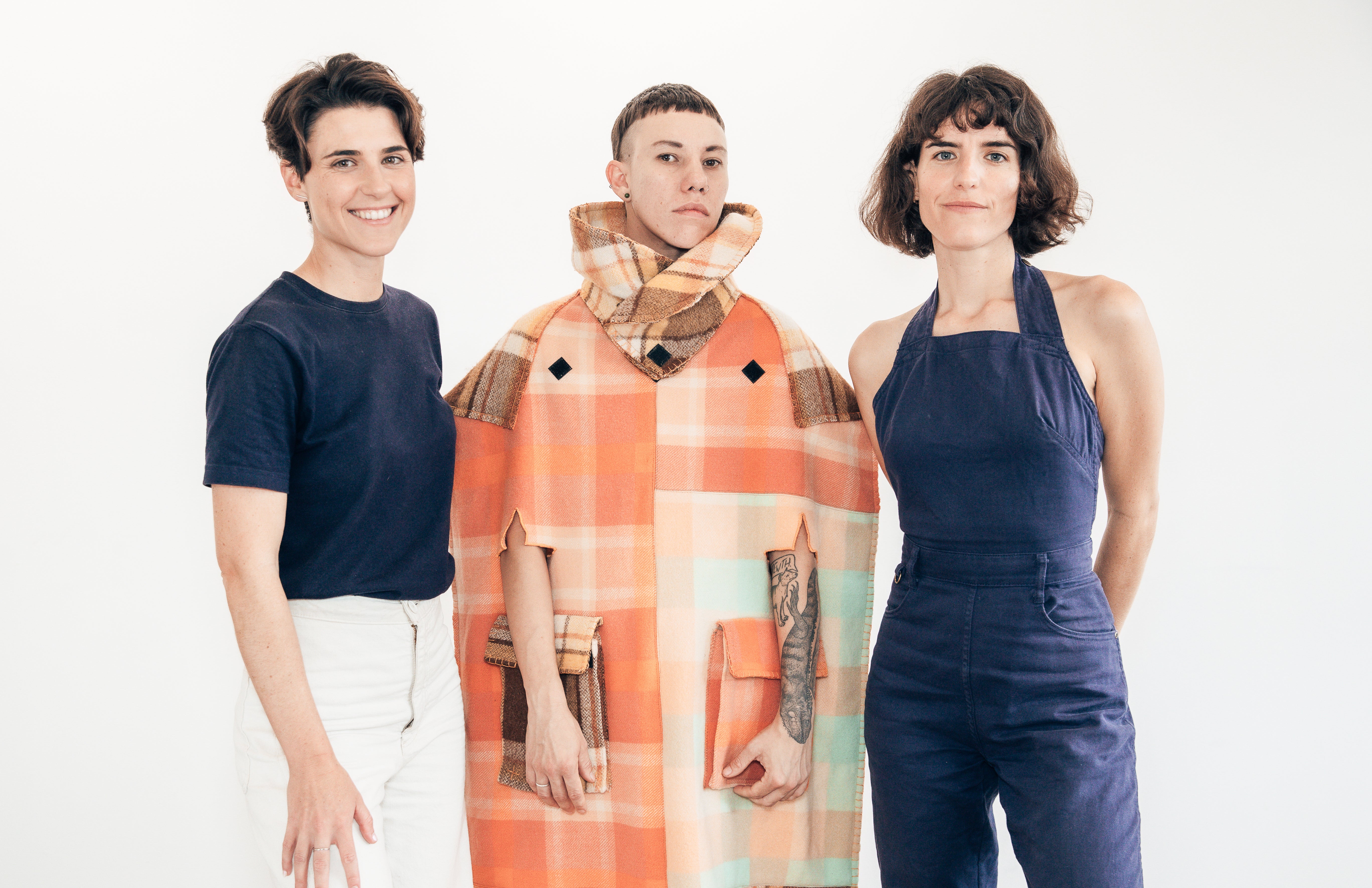Playing with Fire Blanket
Australia’s Black Summer in 2019/2020 made it clear that bushfires are only going to increase in frequency and intensity with a heating climate – indeed all extreme weather events will.
As part of Melbourne Design Week 2021 and Friends & Associates’ show called A World We Don’t Want, we’re exploring how the onus is increasingly on frontline workers, communities and individuals to survive, and wondering how the hell we’re going to do it.
After hearing myriad stories of coming face-to-face with fire, Karina borrowed a local volunteer firefighters jacket, her and Sammy’s grandmother’s refurbished Singer sewing machine and a box of donated wool blankets to experiment.

The result is the Playing with Fire Blanket – a new kind of PPE for fire preparedness at home. A patchwork of reclaimed 100% wool blankets inspired by the fire fighter’s jacket, this wearable blanket provides a cocoon to survive radiant heat, flying embers and ash. Or does it?
The Playing with Fire Blanket uses found materials and craft to comment on responsibility and care in the face of a growing climate reality.

Fire danger in Australia
Due to delayed action on climate change, we are headed for a future in which building resilience is the focus, one where individuals and communities must be more equipped than ever to respond to extreme weather events.
In Australia, bushfire seasons are starting earlier and lasting longer. Southern and Eastern Australia are expected to see drier and warmer conditions that lead to dier fuels that burn easily, so a greater number of days with severe fire danger are projected. Extreme fire days, in which conditions are ideal for bushfire, increased at 24 of 38 sites in Australia between 1973 and 2010. (Climate Change and the Victorian Bushfire Threat Report 2017).
The fires of summer 2019 and 2020 were a shocking manifestation of these forecasts. Experts were stunned by what they were seeing, describing the fires as “the monster”, or a firestorm, where vapor rises to create a storm cloud from which lightning strikes and starts more fires.
 ABC’s show Big Weather and How to Survive it
ABC’s show Big Weather and How to Survive it
"We were one of the first Rural Fire Brigades to arrive at David Low Way. The houses along the road were under heavy ember attack both flowing across the road and overhead. Our task was to protect properties along David Low Way from spot fires on roofs, in yards, gardens, fence lines etc. After the fire had settled we moved to streets further back toward the beach putting out spot fires."
To prepare for fire events, households must be ready to decide if they want to stay and protect their property or leave, and to be well prepared for fighting and surviving the fire. Emergency survival kits include everything from battery operated radio and waterproof torch to woollen blankets and drinking water.
"The fires burned for a number of days with many flare ups. Our brigade provided crews for several days and nights. It was a very traumatic time for residents. The common saying was ‘never did we think this would happen at Peregian’. The local community rallied together and supported each other." – local volunteer firefighter, Peregian Beach, Queensland
The Playing With Fire Blanket
Woollen blankets are used to protect the body from fire because it’s the most fire-resistant fibre – there’s less oxygen in woollen fibres than fire needs to burn. The idea is to cover as much of your body as possible including tucking it underneath you, and having water with you to sit and stay hydrated as the fire passes over you.
This haunting image of survival is what came to mind when we were asked to respond to the brief from Friends & Associates as part of the A World We Don’t Want exhibition for the NGV’s Melbourne Design Week 2021.


The volunteer firefighter in Peregian lent us a full firefighter suit to see how PPE features help protect those on the front line. Karina took the jacket, and a box of 100% old wool blankets that were donated, to construct a blanket that one must get into to protect themselves from fire. Having restored her and Sammy’s grandmother’s Singer from the 70s last year, she got draping, pinning and sewing.

The high, round collar of the firey jacket was dramatised for a sense of security. Deep pockets were decidedly an essential feature to cart around spare batteries, phone and charger, IDs and small valuables.

Extremities, like hands, are vulnerable to fire so there are no sleeves. Rather, the wearer keeps their arms inside, with enough room for water bottles, and there are holes to quickly reach for things as required.

Colours were sorted and arranged to reflect the reds and oranges of flames, browns of burned country and the bright green of regrowth. The finish is a hand-sewn traditional blanket stitch in the mango colour of the borrowed fire jacket, using found yarn. The only new component of the Playing with Fire Blanket is the velcro.

Better fire practices
There are many ways in which experts and communities are working to better understand fire. As well as ‘weather reduction’ or measures taken to mitigate climate change (like stopping the burning of fossil fuels), Indigenous-led cultural burning practices are implemented to reduce fuels and hazards and encourage regeneration. Education in schools is also imperative, as fires are often lit by people.
Bundanon Trust’s We Need To Talk About Fire is a beautiful and informative set of resources that explores the knowledge, initiatives and stories needed to find a way forward.

Warning: this blanket is not survival equipment. For emergency survival kit guidance see your state’s websites including Country Fire Authority Victoria, Queensland’s Rural Fire Service and NSW Rural Fire Service.
Playing with Fire Blanket is modelled here by George Levi and photographed by Sophie Vaughan
